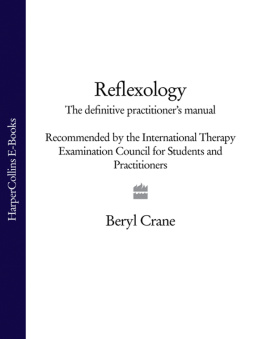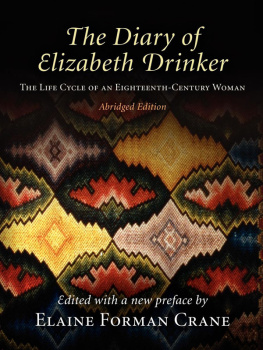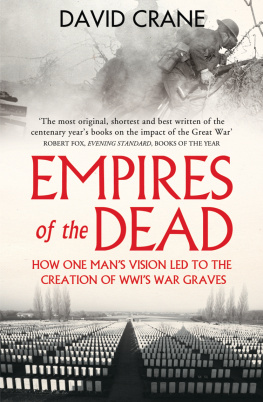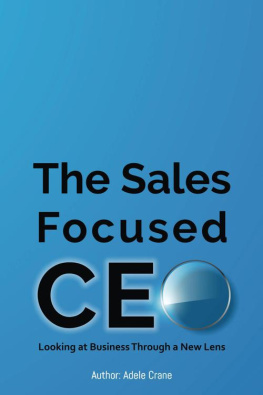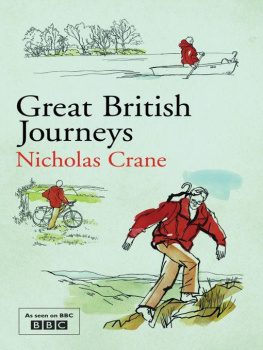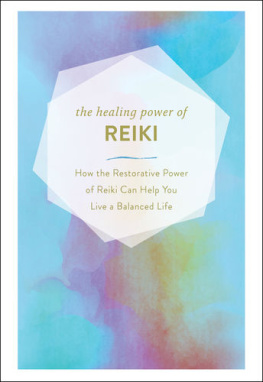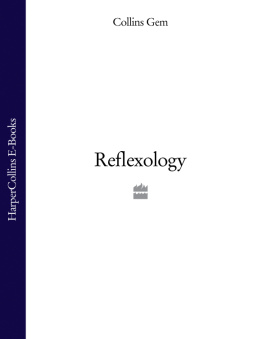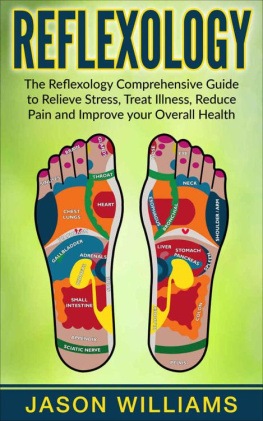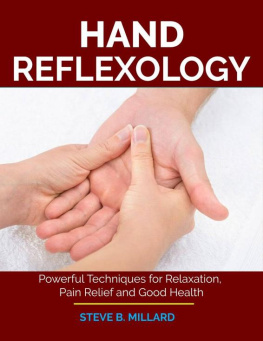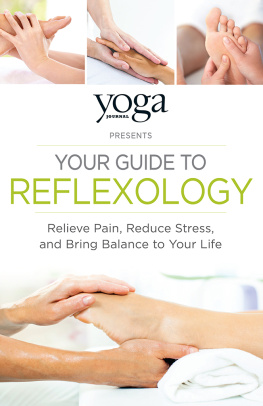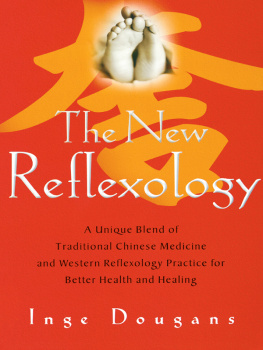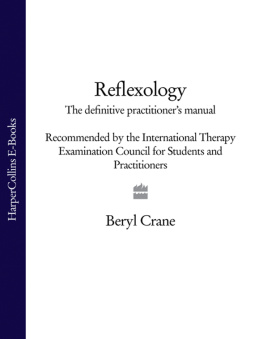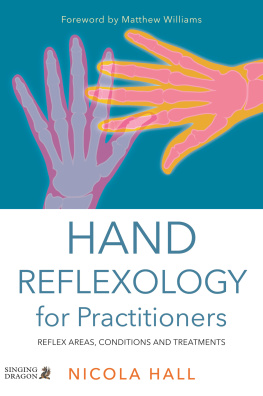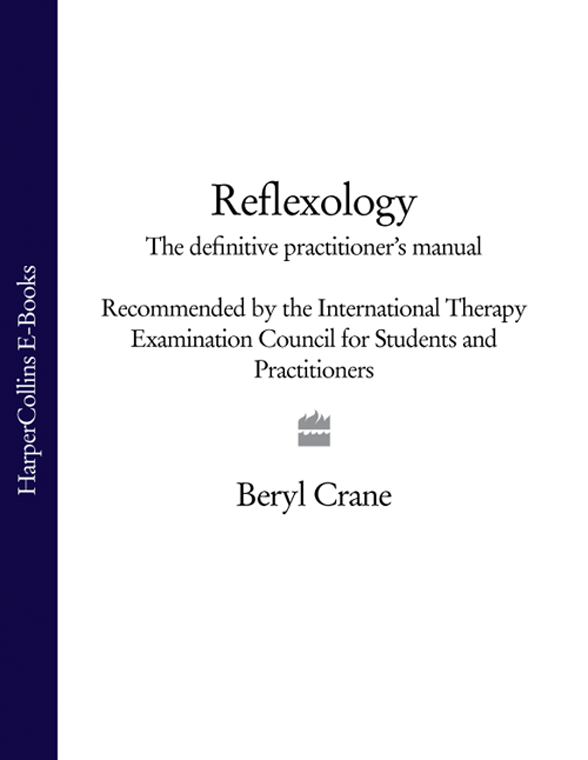I would like to dedicate this book to my husband of 43 years, who I love dearly for his patience, understanding and love, which were sorely tested throughout the time that this book was in the making.
Many thanks to my models: my daughter Alex for the use of her feet and hands, my daughter-in-law Susan for her help in the plate section, and my granddaughter Sarah for the use of her ear. A big thank-you to baby Isaac Verral, who smiled throughout whenever his feet, hands or ears were touched, no matter how long the photographic session took. I would also like to thank my many students and the practitioners who wrote to me encouraging me to write this manual.
Acknowledgements are due to Health Research, Mokelumne Hill, California for continuing to produce facsimiles of the early writings of Fitzgerald, Bowers, White and Shelby-Riley.
I would also like to acknowledge the following works which I have consulted in the course of writing:
The Anatomical Atlas of Chinese Acupuncture Points, Shandong Science and Technology Press, 1982; Blacks Medical Dictionary, A & C Black, 38th edition, 1995; Churchill Livingstone Medical Dictionary, Churchill Livingstone, 14th edition, 1987; Grays Anatomy, Jarrold & Son Publishers, 35th edition, 1973; Badawy, The Tomb of Nyhetep-Ptah and the Tomb of Ankhmahor at Saqqara, University of California Occasional Papers 1978.
The author has been known to me for many years and I have great respect, not only for her expertise in the field of reflexology, but for her very wide knowledge of the subject.
As a complementary therapy, reflexology is daily gaining the approbation of patients and other professionals including general practitioners and hospital doctors. This is due to the work and dedication of reflexologists, of whom Beryl Crane is an outstanding example.
It gives me the greatest of pleasure to recommend this excellent and well researched book to all serious students of this therapy.
Dr William Arnold-Taylor MSc, PhD
Member Clinical Forensic Medicine;
Fellow of the Royal Society of Medicine;
Chairman of the International Therapy Examination Council Limited
Reflexology is a science based on the principle that reflexes, or areas, in the feet, hands and other parts of the body relate to the internal organs and other structures of the body.
There are several definitions of the word reflex, all of which are relevant here:
an involuntary unconscious response to stimuli
a mirror image
to turn or be directed back.
The definition of ology is the study of that branch of science. The term microcosm is also relevant: this is defined as a small system regarded as a little self-contained world that represents all the qualities or activities of something much larger. In reflexology the feet, hands and ears are seen as a perfect microcosm of the body, with a somatic replication of all organs, glands and muscles of the body on to an area or a reflex point. Palpation or pressure on such points helps to achieve balance in the body by normalizing the function of internal organs through a system of zones that link particular reflexes with particular organs. This treatment by pressure helps to stimulate the bodys healing process and to allow the person to achieve physical and emotional well-being. There are many ways to apply pressure. Even wringing the hands or rubbing them together can be quite beneficial, while putting the fingertips together helps to stimulate the brain, and squeezing the fingers can relieve a headache or toothache. The points to which pressure is applied are located by reference to both Traditional Chinese Medicine (TCM) and the zone theory. The area just behind the ball of the foot is known as Bubbling Spring (or Well) point, a vital point in the Chinese meridian theory; this is the same point where the solar plexus is represented on the feet in the reflexology theory. It is on these minute reflex areas that the reflexologist will apply precise alternating pressure techniques, thus bringing about a therapeutic effect on the corresponding area of the body.
Reflexology is truly a holistic non-invasive therapy, where the practitioner sees the patient as a whole; it is most important that the ).
Reflexology is a must for the 21st century. We need to make this age-old therapy an essential part of everyday life for all, young and old alike. Reflexology treatment has many benefits. It leads to a better functioning of the circulatory system, as blood flow is improved, taking all the nutrients to the appropriate parts more efficiently. Blood and nerve supply to muscles improves, aiding and relaxing muscle spasm and tension. The treatment also promotes good muscle tone through nerve stimulation, so reflexology helps compensate for lack of exercise in cases of illness or old age. It also promotes a more active peripheral vascular return. This is especially helpful in people who have a sedentary lifestyle, whose skeletal muscles often lack the ability of squeezing the veins to increase the venous blood pressure; as a result of the therapy their hearts do not have to work quite so hard to bring about the venous return. The person often finds the therapy warming and exhilarating, as it calms the nervous system. Since stress-related problems do not seem to have the same adverse effects the person is better able to cope. Reflexology can in fact be both sedative and stimulating to the nervous system; this is why it benefits and relieves pain in many nervous and autoimmune disorders. Also, the processes of elimination work more efficiently, so that there is no accumulation of excess waste within the system, which many therapists consider the primary cause of disease. Stimulating the circulation helps the elimination of excess waste products and contributes to increase of excretion of fluids. The treatment generally also lessens inflammation, pain, swelling, heat and redness, which may occur as reactions of the bodys tissues to injury. In cases of injury, in reflexology there is no need to touch the impaired part itself. Stimulation to the lymphatics helps the oedema that is often the bodys reaction to injury, and the accumulation of fluids that could also be the result of a defective kidney or a circulatory disorder.
Research on its physiological effects is still in its very early stages; many studies of treatment outcomes have been published but more in-depth clinical trials are needed to verify the many noted outcomes and to test some of the hypotheses so that the possible theories of action can be elucidated. Reflexologists worldwide are communicating with each other to further research that is ). The tradition of pressure for relieving pain has been under much discussion since the late 1800s. Many great medical men have been involved in studies of reflexes and how nerve signals are transmitted, and have shown how such pressure affects the autonomic nervous system, which in turn improves the function of all the organs and structures of the body. Studies of nerve innervation have demonstrated that such pressure either increases or decreases the rate and strength of the heartbeat, depending on whether the sympathetic or parasympathetic nervous system is stimulated. Analysis of the sensory stimulus to the nerve endings by touch shows how reflexology enables the body to provide better functioning of all the structures and organs within it. There is a hypothesis that reflexology treatment may also encourage the process of cell renewal, acting at cellular level to provide better intercellular communication. Studies on outcomes of treatment show that the sensory stimuli to all the reflexes aids the body in repairing itself. Theories of its effect include activation of the sebaceous glands and sweat glands, which help in moisturizing and lubricating the skin. Other glands and organs would also benefit by stimulation of the blood circulation, because this is like a transport system, and through the continuous flow of blood around the body nutrients from the alimentary tract are distributed to all tissues of the body. So more oxygen from the lungs reaches all the tissues, and waste material (including carbon dioxide) is transported to the excretory surfaces. Hormones are transported from endocrine glands to other organs and tissues. In the immune system the lymphocytes, which have a defensive action in removing waste, germs and dead cells, are activated. The leucocytes, or white blood cells, are transported to the site of infection quicker, helping to reduce pain and stiffness of joints, improving mobility, and helping in antibody production.

